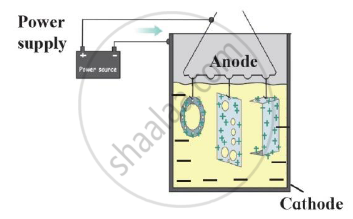Advertisements
Advertisements
प्रश्न
No chemical reaction takes place when granules of a rusty-brown solid A are mixed with the powder of another solid B. However, when the mixture is heated, a reaction takes place between its components. One of the products C is a metal and settles down in the molten state while the other product D floats over it. It was observed that the reaction is highly exothermic.
(a) What could the solids A and B be?
(b) What are the products C and D most likely to be?
(c) Write the chemical equation for the reaction between A and B leading to the formation of C and D. Mention the physical states of all the reactants and products in this equation and indicate the heat change which takes place.
(d) What is the special name of such a reaction? State one use of such a reaction.
(e) Name any two types of chemical reactions under which the above reaction can be classified.
उत्तर
(a) The rusty-brown solid A is iron (III) oxide and another solid B is aluminium. Mixing of iron granules with aluminium powder will have no reaction.
(b) The product are likely to be C (iron) and D (aluminium oxide). Once the mixture of iron (III) oxide granules and aluminium powder is heated, aluminium acts as reducing agent. Aluminium reduces iron (III) oxide to iron and aluminium powder oxidises to aluminium oxide with the liberation of excess heat.
(c) 
When A (iron (III) oxide) and B (aluminium powder) are heated, iron and aluminium oxide get produced with the liberation of excess heat. Thus, the product C is iron and product D is aluminium oxide. As excess heat is liberated in the reaction, the product C, i.e., iron metal, is in the molten state.
(d) The special name given to this reaction is thermite reaction. This reaction is widely used to weld broken hard substances like iron in railway tracks. This process of welding is called thermite welding.
(e) The above said reaction can be classified into displacement reaction and oxidation-reduction reaction. Aluminium, being more reactive than iron, displaces iron in iron (III) oxide, undergoing displacement reaction. Aluminium also acts as a reducing agent and reduces iron (III) oxide to iron metal and gets oxidised to aluminium oxide, undergoing oxidation-reduction reaction.
APPEARS IN
संबंधित प्रश्न
Give reasons:
Platinum, gold and silver are used to make jewellery.
Explain why Iron sheets are coated with zinc during galvanization.
Name any two metals which do not corrode easily.
Name two metals which resist corrosion due to the formation of a thin, hard and impervious layer of oxide on their surface.
Explain why, the galvanised iron article is protected against rusting even if the zinc layer is broken.
A metal X which is resistant to corrosion is produced by the electrolysis of its molten oxide whereas another metal Y which is also resistant to corrosion is produced by the reduction of its oxide with carbon. Metal X can be used in powder form in thermite welding whereas metal Y is used in making cathodes of ordinary dry cells.
(a) Name the metals X and Y.
(b) Which of the two metals is more reactive : X or Y?
(c) Name one ore or metal X. Also write its chemical formula.
(d) Name one ore or metal Y. Also write its chemical formula.
(e) Name one alloy of metal X and one alloy of metal Y.
Four metals P, Q, R and S are all obtained by the reduction of their oxides with carbon. Metal P is used to form a thin layer over the sheets of metal S to prevent its corrosion. Metal Q is used for electroplating tiffin boxes made of metal S whereas metal R is used in making car batteries. Metals Q and R form an alloy called solder. What are metals P, Q, R and S? How have you arrived at this conclusion?
Name the metal which is a constituent of blood pigment?
Identify the process shown in the diagram and explain it in short

Write three methods of preventing rusting of iron.
Explain the term – rusting and give a word equation for the formation of rust. If polished iron nails are kept in three separate test tubes, state the contents in each test tube required, to prove the conditions for rusting.
State whether the statement given below is true or false. If false write the correct statement.
Either oxygen or moisture is essential for rusting.
_______ is an alloy made from iron, carbon and chromium.
To prevent corrosion of iron and steel _______ method is used.
Bronze : _______ : : Stainless steel : Fe + Cr + C
Match the columns.
| Group A | Group B |
| 1) Electroplating | a) Pressure cooker |
| 2) Anodising | b) Silver plated spoons |
| c) Coating of tin on copper | |
| d) Coating of Zinc on iron |
Draw a neat labelled diagram.
Electroplating
Observe the following figure and write the answer of the question.

- Which process is shown in the figure?
- Explain the chemical reaction shown in the figure.
- Write the reactions on anode and cathode.
Explain the following:
Lime water turns milky on passing carbon dioxide gas into it.
